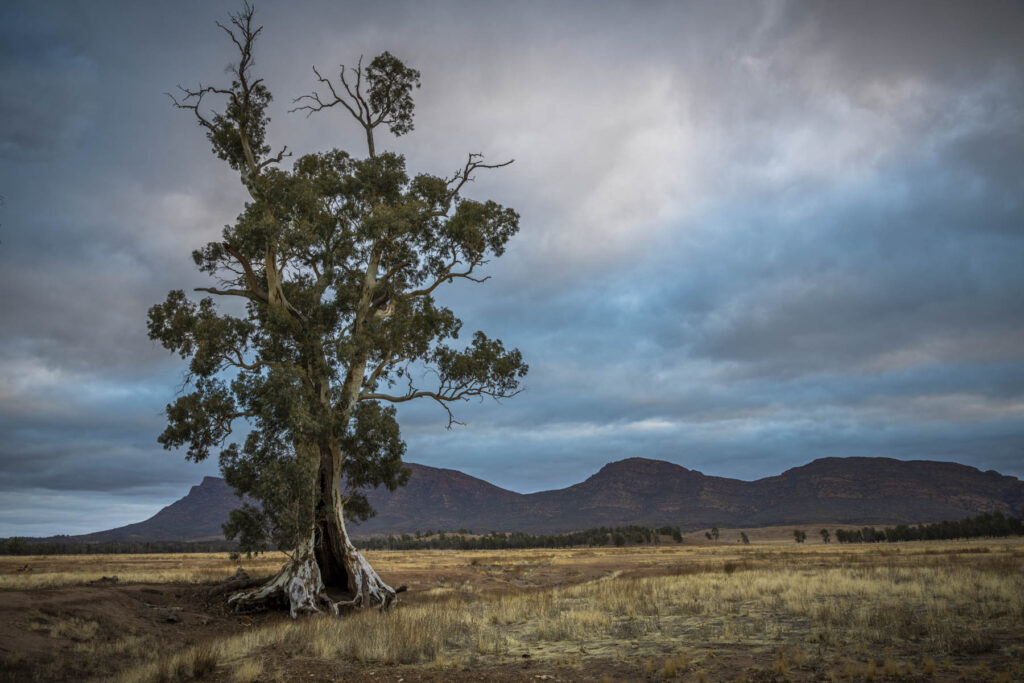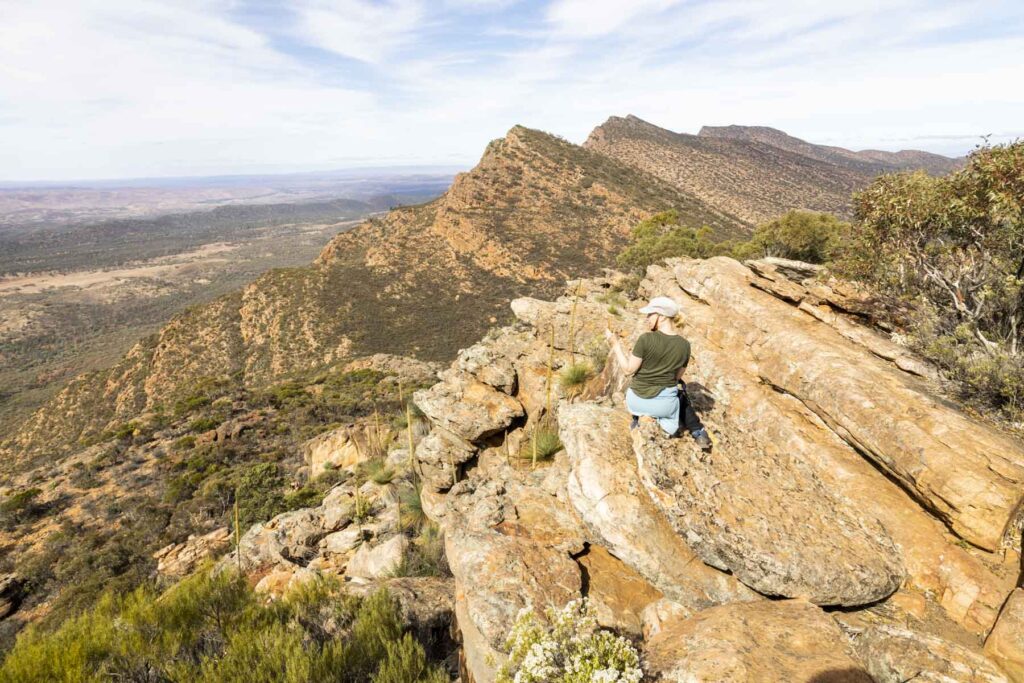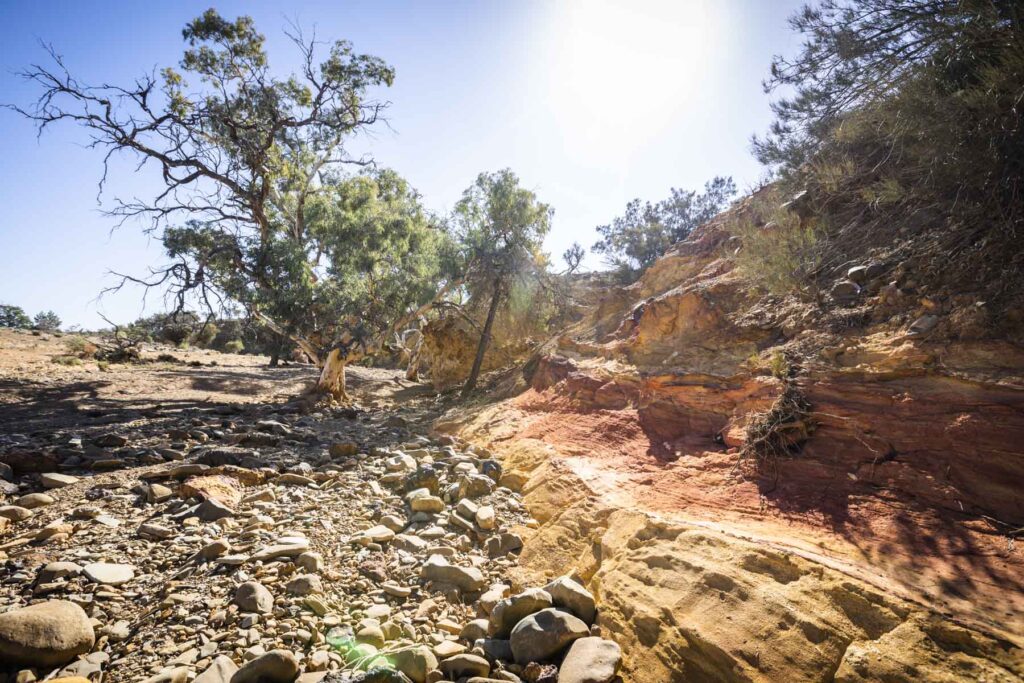Australia
Popping skies and stars in Flinders Ranges
At Wilpena Pound we walked to Hills Homestead, through the tall River Red Gum and pine trees, jumped a puddle and stopped to admire the watering hole with its ‘no swimming’ sign.
We weren’t tempted to swim. Not at this time of the year when the days are a perfect walking temperature and the nights dip down below zero.
But I can imagine that in summer, a swim in this watering hole, after the long walk would be particularly enticing.
We pushed on to Hill’s Homestead, the home of the original settlers in the area, and learned about the harshness of the Australian landscape and the challenges the original owners faced. Walking around the brick cottage, past the abandoned farming machinery always makes me wonder how they carted this stuff into these remote locations.
And why.
Behind the homestead is a large carved boulder on which an Aboriginal man points the way to Wangara Lookout. A rocky path weaves up the side of the mountain to the viewing platforms. We climbed first to one lookout, about 150 metres straight up, and then up to the second lookout, about 450 metres up, from where we could see into Wilpena Pound – a kind of plain surrounded by the mountains that make up Flinders Ranges.
The next day we were up early to tackle those mountains. We scrambled over rocks, through thick brush and along craggy rock edges to reach Olhsen Bagge lookout. A cracked concrete marker in the ground marked the lookout and two goats watched as we peered out over the edge, balanced precariously on the rocky mountaintop.
From our vantage point we could see for miles. The sun beat down and the surrounding mountains met the endless blue sky.
We marvelled over the changing colours in the earth surrounding us.
We drove out to the Cazneaux Tree. Quite why this particular tree caught photographer Harold Cazneaux’s eye I’m not sure. There are so many unique and beautiful trees in this particular spot – so much so that we oohed and aahed over at least three before figuring out which was the tree we were actually here to see.
Ade, of course, photographed them all, from every possible angle.
We spent three nights at Wilpena Pound, in a cramped campground, with stunning trees all around us and from where we could look up at the mountain peaks of the range and marvel at the surrounding bird life.
From Wilpena Pound we drove just up the road to Willow Springs, a working sheep station spread across 70,000 acres which beckoned with its 80-kilometre long four-wheel drive track – the Skytrek Trail.
The road is rough and the drive takes you through canyons and over mountains, a guide booklet provided by the ranch owners points out significant stops along the way including Aboriginal art, ochre canyons, an old cottage and unusual landscapes.
We bounced our way over the ruts in the road, alongside mountains that looked like pyramids and plains that stretched on seemingly forever.
At night we watched as the stars came out to play, filling up the sky. We marvelled over the brightness of the Milky Way.
But in the morning, the result of the cloudless sky was not so welcome. When I woke up water was dripping through the tent on to my forehead. It was seeping through onto our pillows and sleeping bags.
It wasn’t raining, it was frost, a lot of which was dripping into the tent and in under the awning circling the Delica.
The cloudless sky had brought freezing temperatures, ice covered the tent and the awning and when it melted in the morning sun it dripped through the canvas.
We’ve never encountered this before.
I was not happy. Was almost ready to pack up and go home.
But then in the afternoon we did a loop drive, past the Joseph Wills ruins, which stretched on along an easy walking track, through two gorges and up to Razorback Lookout, where the road ahead edged its way precariously over the mountain tops stretching out before us.
And then, just before sunset, we headed up to a lookout where we had 360 degree views of the mountain ranges that surrounded us and where the colours in the sky popped and danced as the sun went down.
And the dripping water of the morning, the ice on the tent and the cold became nothing more than a funny little anecdote to an otherwise beautiful stop on our crazy, fun, middle aged adventure.
Read more about our adventures in Australia here.
Fast Facts
We travelled in 2021.
We spent seven nights in the Flinders Ranges (it was meant to be eight but car trouble at Broken Hill meant we arrived a day later than expected).
We stayed at Wilpena Pound and Willow Springs station.
Was it long enough? We saw everything we wanted to see but more time would allow you to explore further in the region.
Highlights: Staring up at the abundance of stars in the night sky and the clarity of the Milky Way. It is impossible to imagine the volume of stars in the sky until you see it from the Australian outback. Scrambling over rocks on craggy mountain peaks and soaking in never-ending mountain views.
Join @AllAbroadAU on Facebook, Instagram, X and YouTube for more travel inspiration.




